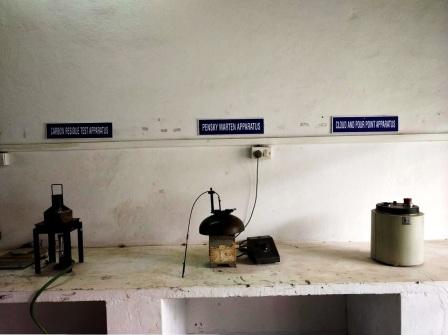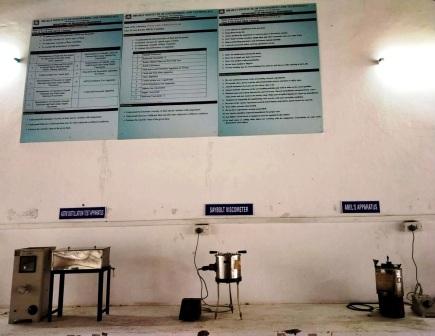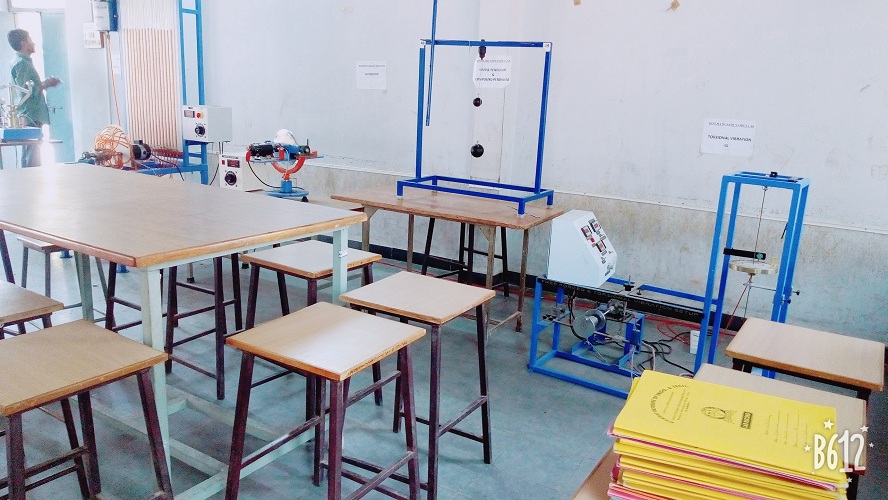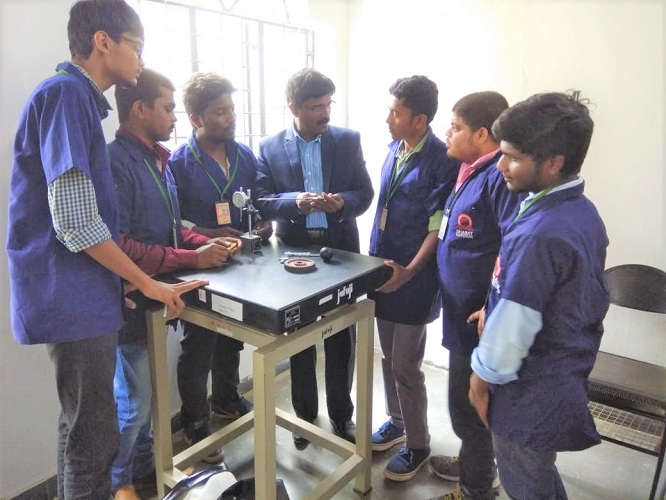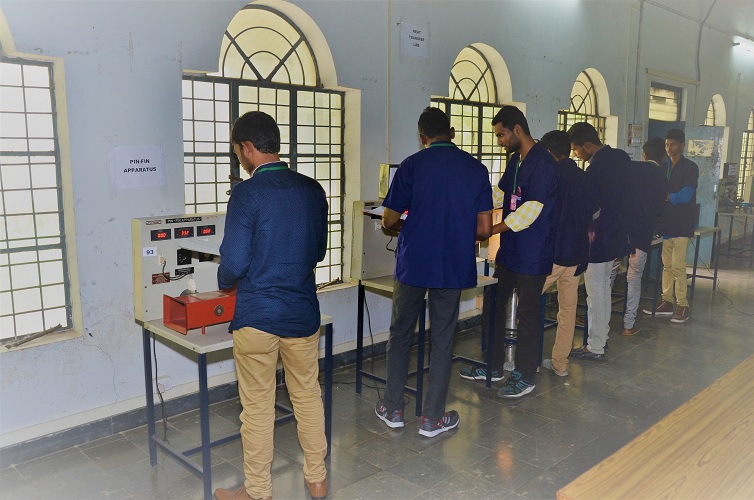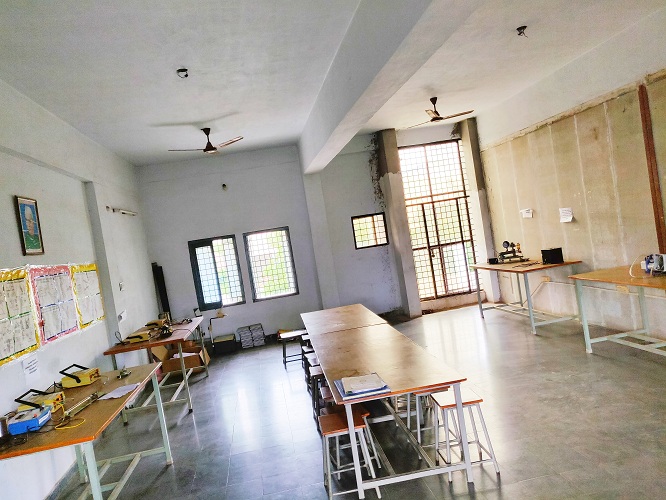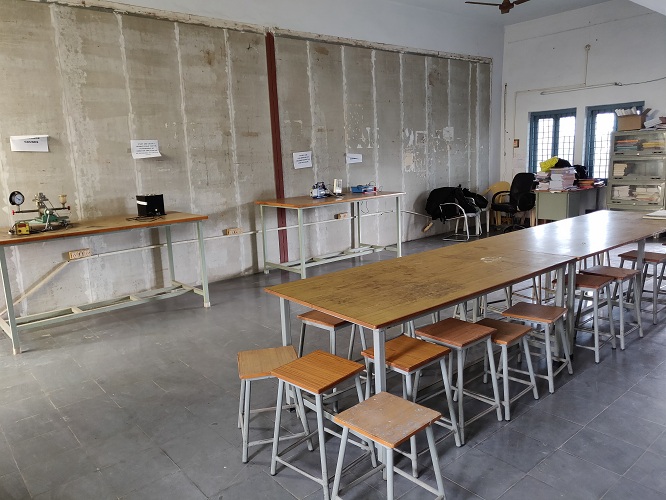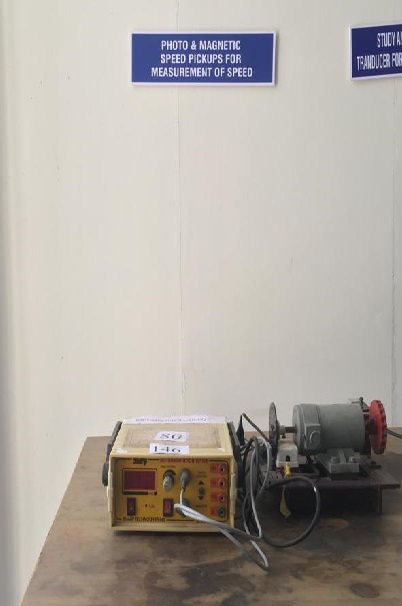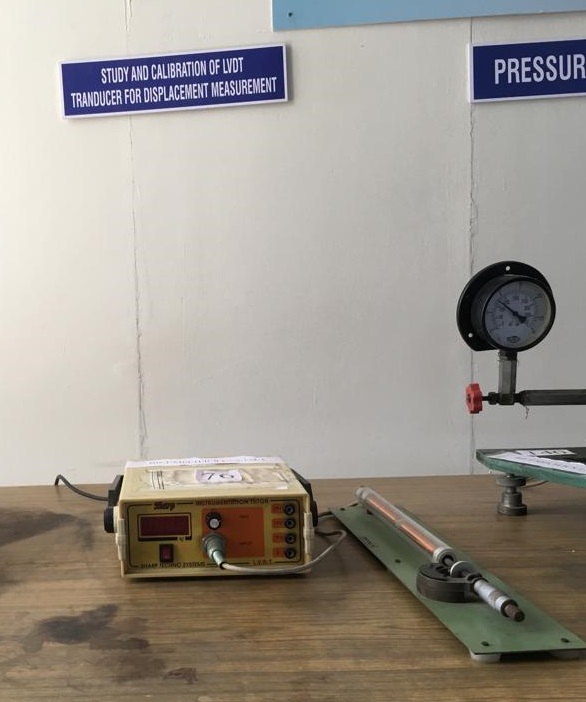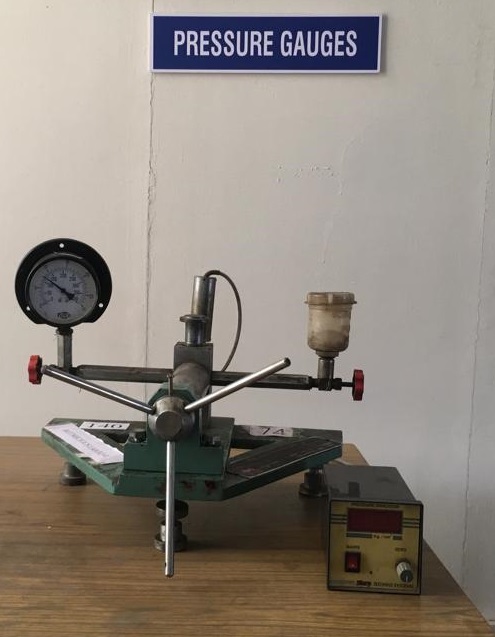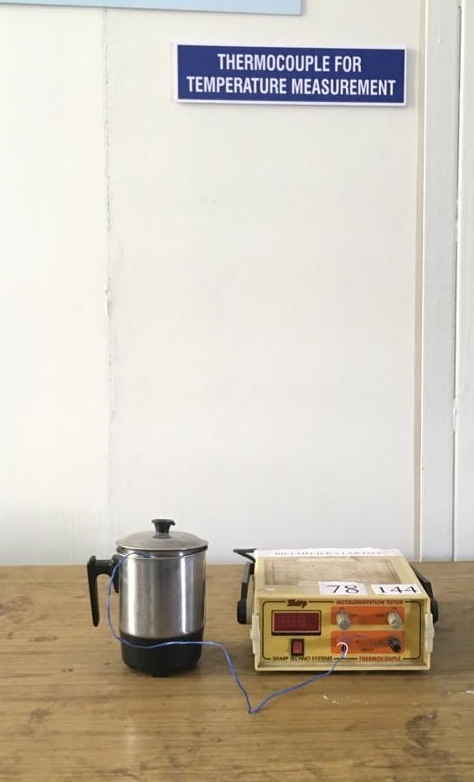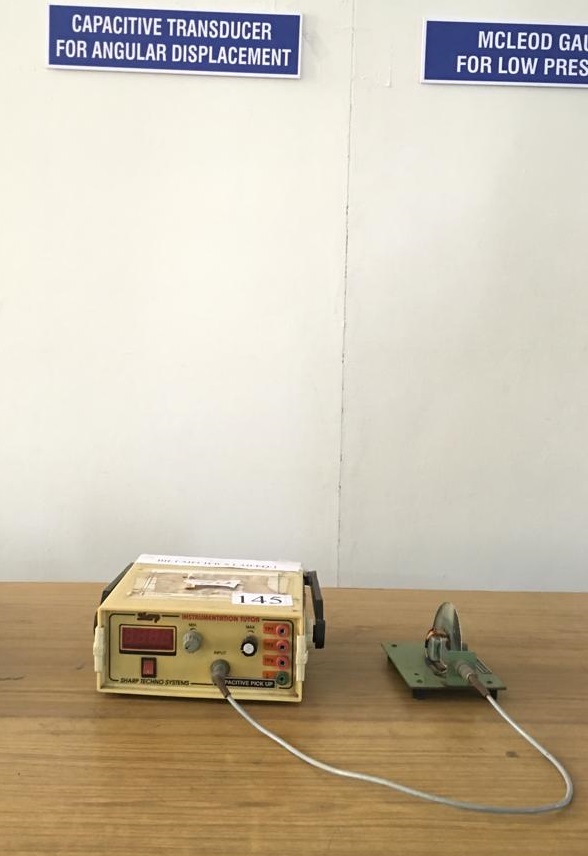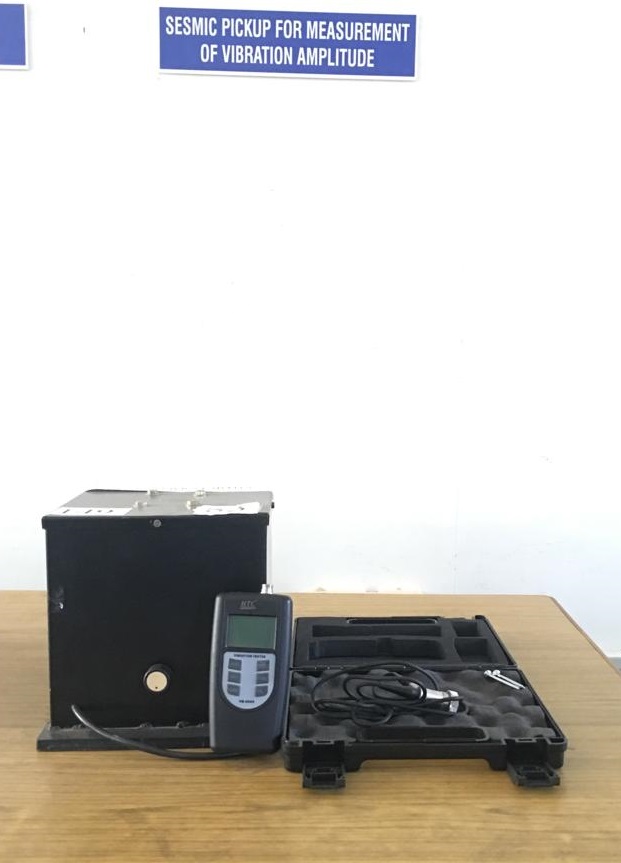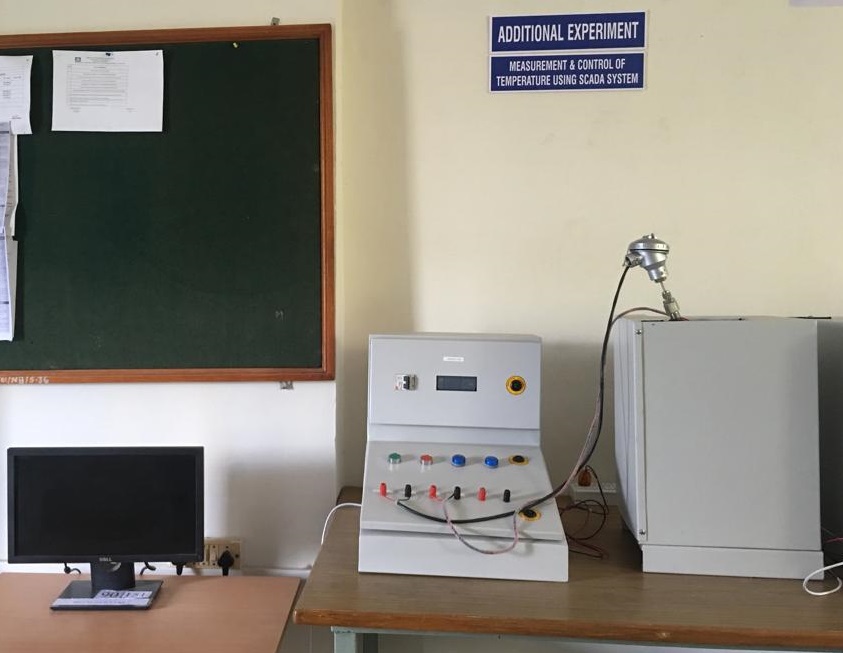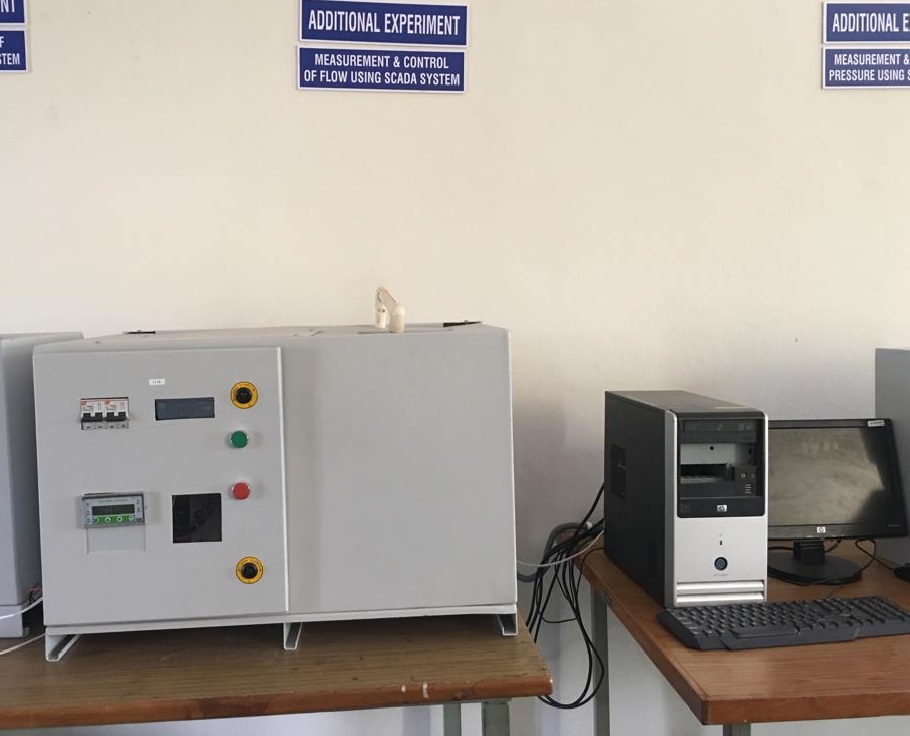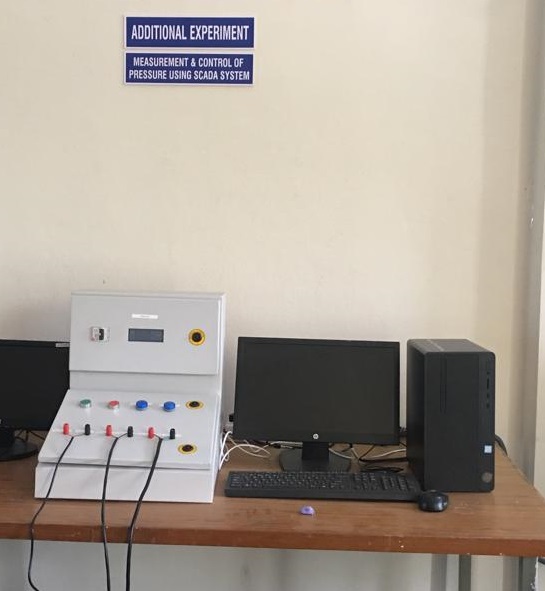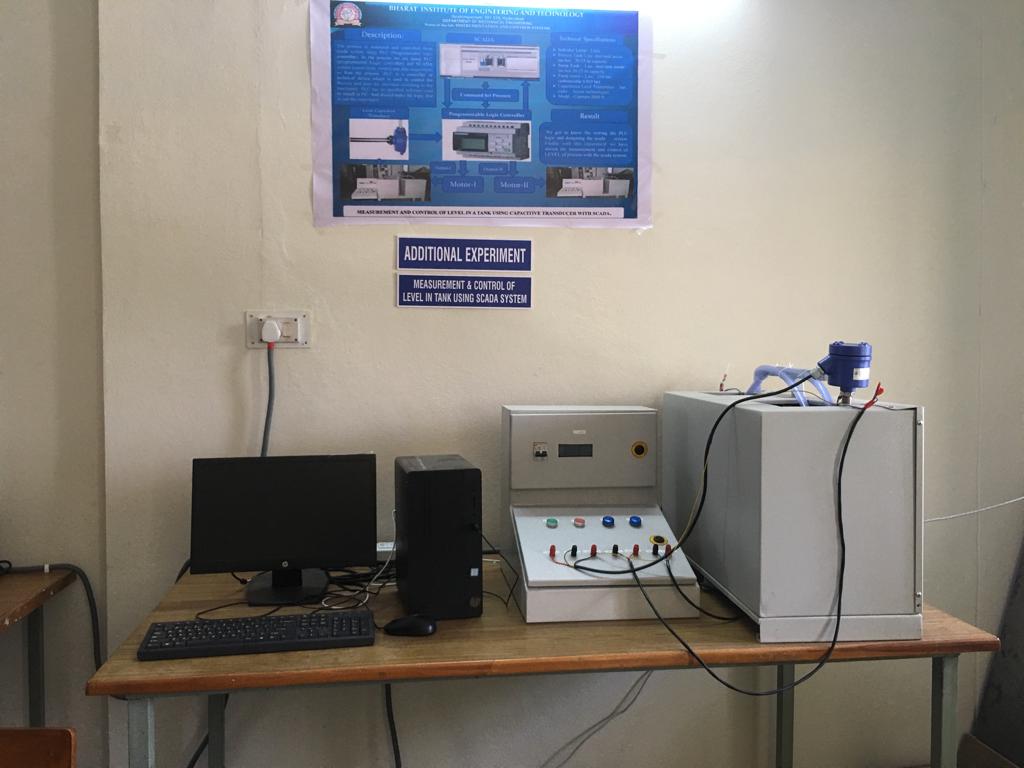LABORATORIES
The laboratories / workshops are fully equipped with complete set of latest equipment’s and tools, in different areas of Physics, Chemistry and Mathematics. The various labs and workshops encompass the vital aspects of Computational Mathematics, Computer Programming, Data Structures, Basic Engineering Workshop, Electrical and Electronics Circuits and Engineering Drawing etc.
Detail of various laboratories and their facilities are as follow:
Metallurgy and Material Science Lab
Fluid Mechanics & Hydraulics Machines Lab
1. Engineering Workshop
Course Objectives
To Study of different hand operated power tools, uses and their demonstration.
1) To gain a good basic working knowledge required for the production of various engineering products.
2) To provide hands on experience about use of different engineering materials, tools,equipment and processes those are common in the engineering field.
3) To develop a right attitude, team working, precision and safety at work place.
4) It explains the construction, function, use and application of different working tools,equipment and machines.
5) To study commonly used carpentry joints.
6) To have practical exposure to various welding and joining processes.
7) Identify and use marking out tools, hand tools, measuring equipment and to work toprescribed tolerances.
Course Outcomes
Upon completion of this laboratory course, students will be able to …
1) Study and practice on machine tools and their operations
2) Practice on manufacturing of components using workshop trades including pluming,fitting, carpentry, foundry, house wiring and welding.
3) Identify and apply suitable tools for different trades of Engineering processesincluding drilling, material removing, measuring, chiselling.
4) Apply basic electrical engineering knowledge for house wiring practice.
List of Equipment
| Sno | Trade Name | Tools/ Equipments |
| 1 | Carpentry | Chisels,Jack plane,Wooden mallet,Try Square, Wood turning Lathe Machine, Carpentry Wise |
| 2 | Tin Smithy | Steel Rule,Snips,Nose pliar, Scriber |
| 3 | House Wiring | Holders, Testers,Wires |
| 4 | Fitting | Bench vice, Files, Punches, Hammers, Hacksaw |
| 5 | Welding | Electrode, Electrode holder, Safety Equipment, DC Machine |
| 6 | Black Smithy | Furnace, Tongs, Anvil, Sledge Hammer |
2. Fuels and Lubricants Lab
Course Objectives
To Understand the fuel and lubricants properties.
1) To develop an idea of fuel properties and their variation with temperature.
2) To determine kinematic viscosity and calorific value of fuels.
3) To determine friction power and volumetric efficiency of IC Engines and the use of multi stage compression.
Course Outcomes
Upon completion of this laboratory course, students will be able to…
1) Compare the flash, fire points and carbon residue of different fuels
2) Find the absolute and kinematic viscosity of different fuels
3) Conduct constant and variable speed tests on IC engines and predict their performance
4) Compare the performance parameters of conventional and computer aided CI engines
List of Equipment
| 1 | Able’s Flash and Fire point Apparatus |
| 2 | Bomb Calorimeter |
| 3 | Condarson Carbon Residue Apparatus |
| 4 | Engler Viscometer |
| 5 | Grease Penetrometer. |
| 6 | Pensky Martin Apparatus |
| 7 | Redwood Viscometer-I. |
| 8 | Redwood Viscometer-II |
| 9 | Saybolt Viscometer |
| 10. | ASTM Distillation Apparatus |
| 11. | Cloud and pour point Apparatus |
| 12. | Junker's Calorimeter |
3. Metallurgy and Material Science Lab
Course Objectives
The purpose of this course is to make the students learn the concepts of Metallurgy and Material Science role in all manufacturing processes which convert raw materials into useful products adapted to human needs.
Course Outcomes
Upon completion of this laboratory course, students will be able to …
1) To provide undergraduates with a fundamental knowledge based associated materials properties, and their selection and application.
2) Upon graduation, students would have acquired and developed the necessary background and skills for successful careers in the materials-related industries.
List of Equipment
| 1 | Binocular metallurgical microscope |
| 2 | Electrical muffle furnace with digital indicator |
| 3 | Belt polishing machine |
| 4 | Lynx Monocular metallurgical microscope |
| 5 | Rockwell hardness tester |
| 6 | Single disk polishing machine |
| 7 | Specimen hot drier |
| 8 | Specimen levier |
| 9 | Wet and dry polisher |
| 10 | Jomney and quench apparatus |
4. Kinematics and Dynamics Lab
Course Objectives
The objective of the lab is to understand the kinematics and dynamics of mechanical elements such as linkages, gears, cams and learn to design such elements to accomplish desired motions or tasks.
Course Outcomes
Upon completion of this laboratory course, students will be able to …
1) Understand types of motion.
2) Analyse forces and torques of components in linkages
3) Understand static and dynamic balance
4) Understand forward and inverse kinematics of open-loop mechanisms
List of Equipment
| 1 | Simple Pendulum |
| 2 | Compound Pendulum |
| 3 | Journal Bearing apparatus |
| 4 | Porter and Proell governor apparatus |
| 5 | Torsional Vibration apparatus |
| 6 | Static and Dynamic balancing machine |
| 7 | Whirling of shaft apparatus |
| 8 | Gyroscope apparatus |
| 9 | Longitudinal Vibration apparatus |
5. Fluid Mechanics and Hydraulic Machines Lab
Course Objectives
This laboratory course is intended to make the students experiment on utility systems and components used in industrial and domestic applications. Students will learn following objectives.
1) To understand the basic principles of fluid mechanics.
2) To identify various types of flows.
3) To understand boundary layer concepts and flow through pipes.
4) To evaluate the performance of hydraulic turbines.
5) To understand the functioning and characteristic curves of pumps.
Course Outcomes
1) Understand the effect of fluid properties on a flow system.
2) Understand type of fluid flow patterns and describe continuity equation.
3) Analyse variety of practical fluid flow and measuring devices and utilize fluid mechanics principles in design.
4) Analyse an appropriate turbine with reference to given situation in power plants.
5) Estimate performance parameters of a given Centrifugal and Reciprocating pump.
6) Demonstrate boundary layer concepts
List of Equipment
| 1 | Impact of jets on Vanes Test Rig |
| 2 | Pelton Wheel Test Rig |
| 3 | Francis Turbine Test Rig |
| 4 | Kaplan Turbine Test Rig |
| 5 | Single Stage Centrifugal Pump Test Rig |
| 6 | Multi Stage Centrifugal Pump Test Rig |
| 7 | Reciprocating Pump Test Rig |
| 8 | Venturimeter & Orifice meter Test Rig |
| 9 | Determination of friction factor for a given pipe line (Major losses) |
| 10 | Flow through pipes to study minor losses |
| 11 | Bernoulli’s Theorems Apparatus |
6. Manufacturing Process Lab
Course Objectives
1) Know about the basic Physical, Chemical Properties of materials
2) Explain why some material(s) are better to be used in a product for given design requirements
3) Learn the basic operation of various manufacturing processes
4) Learn how various products are made using traditional, non-traditional, or Electronic, manufacturing processes.
5) Design simple process plans for parts and products.
6) Understand how process conditions are set for optimization of production
7) Learn how CNC machines work
8) Write and execute CNC machining programs to cut parts on a milling machine
9) Measure a given manufactured part to evaluate its size, tolerances and surface finish
10) Design and fabricate a simple product
Course Outcomes
Upon completion of this laboratory course, students will be able to
1) Understand the properties of moulding sands and pattern making.
2) Fabricate joints using gas welding and arc welding. Evaluate the quality of welded joints.
3) Basic idea of press working tools and performs moulding studies on plastics.
List of Equipment
| 1 | Arc welding |
| 2 | Foundary Tools |
| 3 | Tig welding |
| 4 | Wood turning lathe |
| 5 | Fly press |
| 6 | Injection moulding |
| 7 | Blow moulding |
| 8 | Plasma welding |
| 9 | Casting |
| 10 | Hydraulic press |
| 11 | Sand permeability |
| 12 | Sand drammer |
| 13 | Sand strength machine |
| 14 | Spot welding |
| 15 | Induction Furnace |
7. Thermal Engineering Lab
Course Objectives
1) To understand the working principles of IC Engines, Compressors
2) To learn the testing methods used to measure the performance parameters of an engine
Course Outcomes
Upon completion of this laboratory course, students will be able to …
1) Conduct constant and variable speed tests on IC engines and predict their performance
2) Compare the performance parameters of conventional and computer aided CI engines
3) Dis-assemble and Assemble a 4-stroke and 2-stroke engine.
List of Equipment
| 1 | Diesel Engine Cut Section Model |
| 2 | Petrol Engine Cut Section Model |
| 3 | Diesel Engine Test Rig(Slow Speed) |
| 4 | Diesel Engine Test Rig(High Speed) |
| 5 | 2-Stroke Single Cylinder Petrol Engine Test Rig With Mechanical Loading – Air Cooled |
| 6 | 4-Stroke 4 Cylinder Petrol Engine Test Rig – Morse Test |
| 7 | Diesel Engine Assembly |
| 8 | Petrol Engine With All Parts |
| 9 | Variable Compression Ratio Petrol Engine Test Rig |
| 10 | Air Compressor Test Rig |
| 11 | Petrol Engine Test Rig With Electrical Loading |
| 12 | Boiler Models |
8. Machine Tools Lab
Course Objectives
To Study of different hand operated power tools, uses and their demonstration.
1) To import practical exposure to the Machine tools
2) To conduct experiments and understand the working of the same.
Course Outcomes
Upon completion of this laboratory course, students will be able to …
1) Acquire skills on welding metal plates using arc and gas welding equipment
2) Perform various machining operations like turning, thread cutting, slotting and keyways
List of Equipment
| 1 | Lathe machines |
| 2 | Drilling machine |
| 3 | Milling machine |
| 4 | Shaper |
| 5 | Planing machne |
| 6 | Sloting machine |
| 7 | Cylindrical grinder |
| 8 | Surface grinder |
| 9 | Tool & cutter grinder |
9. Engineering Metrology Lab
Course Objectives
1) To import practical exposure to the metrology equipment
2) To conduct experiments and understand the working of the same.
Course Outcomes
Upon completion of this laboratory course, students will be able to …
1) Explain working principles and use of instruments
2) Adopt the appropriate instrument/gauge for the measurement of a given dimension
3) Measure the given parameter/dimension with precision and skill
List of Equipment
| 1 | Gear tooth vernier |
| 2 | Vernier calipers (manual and digital types) |
| 3 | Vernier depth guage |
| 4 | Vernier height guage |
| 5 | Micrometer screw guage |
| 6 | Tool maker’s microscope |
| 7 | Bevel protractor |
| 8 | Sine bar |
| 9 | Screw thread micrometer |
| 10 | Set of slip guages precision bench center |
| 11 | Dial indicator |
| 12 | Plain plug guage |
| 13 | Bore guage |
| 14 | Precision spirit level |
| 15 | Optical flat |
| 16 | Granite surface plate |
| 17 | Taper plug guage |
| 18 | Adjustable snap guage |
| 19 | Angle plate |
| 20 | Gear tooth vernier |
10. Heat Transfer Lab
Course Objectives
To enable the student to apply conduction, convection and radiation heat transfer concepts to practical applications.
Course Outcomes
Upon completion of this laboratory course, students will be able to …
1) Perform steady state conduction experiments to estimate thermal conductivity ofdifferent materials
2) Perform transient heat conduction experiment
3) Estimate heat transfer coefficients in forced convection, free convection,condensation and correlate with theoretical values
4) Obtain variation of temperature along the length of the pin fin under forced and freeconvection
5) Perform radiation experiments: Determine surface emissivity of a test plate andStefan- Boltzmann’s constant and compare with theoretical value
List of Equipment
| 1 | COMPOSITE WALL APPARATUS |
| 2 | LAGGED PIPE APPARATUS |
| 3 | CONCENTRIC SPHERE APPARATUS |
| 4 | METAL ROD FOR THERMAL CONDUCTIVITY |
| 5 | PIN-FIN APPARATUS |
| 6 | TRANSIENT HEAT CONDUCTION APPARATUS |
| 7 | FORCED CONVECTION APPARATUS |
| 8 | NATURAL CONVECTION APPARATUS |
| 9 | PARALLEL & COUNTER FLOW HEAT EXCHANGER |
| 10. | EMISSIVITY APPARATUS |
| 11. | STEFAN BOLTZMAN’S APPARATUS |
| 12. | CRITICAL HEAT FLUX APPARATUS |
| 13. | HEAT PIPE DEMONSTRATOR APPARATUS |
| 14. | FILM AND DROP WISE CONDENSATION APPARATUS |
11. CAD and MAT LAB
Course Objectives
1) To acquaint the student with some of the terminology in this very new field and relate it to the basic engineering process of design,
2) To provide an introduction to the basic analytical fundamentals that are used to createand manipulate geometric models in a computer program,
3) To introduce the student to full-scale CAD software systems designed for geometricmodelling of engineering components and systems (attention will be directed at bothdrafting and full 3-D modelling systems),
4) To provide experience in using the CAD tools to develop a simple project ofreasonable complexity, and
5) To provide a brief survey of methods for integrating these tools into a comprehensivedesign system that incorporates advanced database management concepts.
Course Outcomes
1) Students should be able to apply computer methods for solving a wide range ofengineering problems.
2) Students should be able to use computer engineering software to solve and presentproblem solutions in a technical format.
3) Students should be able to utilize computer skills to enhance learning andperformance in other engineering and science courses.
4) And finally, students should be able to demonstrate professionalism in interactionswith Colleagues, faculty, and staff.
List of Equipment
| 1 | AUTOCAD |
| 2 | Pro-e |
| 3 | Ansys |
| 4 | Mat Lab |
12. Computer Aided Manufacturing Lab
Course Objectives
1) Exposure to CAD tools for use in mechanical engineering design conceptualization, geometric modelling, communication, analysis and optimization, further use in CAD, CAM, CAE. 2) Impart knowledge related to principles, methods and techniques of 3D modelling in parametric CAD software. 3) Undertake project works in use of CAD geometric modelling software for design analysis, evaluation and optimization of mass properties, static-stresses, thermal deformations, etc. using professional software. 4) To provide an experiential learning environment, while applying CAD, CAE tools to design of simple parts, assemblies, mechanisms and structures 5) To Introduce the students to the standard terminologies, conventions,processes, operations, design and operational characteristics of key hardware components,programming techniques, applications, merits and demerits of Computer Numerical Controlled(CNC) machines.
Course Outcomes
Upon completion of this laboratory course, students will be able to …
1) Use parametric 3D CAD software tools in the correct manner for making geometric part models,assemblies and automated drawings of mechanical components and assemblies.
2) Evaluate design, analyze and optimize using commercial CAD, CAE software as black box forrequired mass properties/ stress, deflection / temperature distribution etc. under realistic loadingand constraining conditions.
3) Apply the concepts of machining for the purpose of selection of appropriate machining centres, machining parameters, select appropriate cutting tools for CNC milling and turning equipment, set-up, program, and operate CNC milling and turning equipment.
4) Create and validate NC part program data using manual data input (MDI) and automaticallyusing standard commercial CAM package for manufacturing of required component using CNC milling or turning applications.
5) Produce an industrial component by interpreting 3D part model/ part drawings usingComputer Aided Manufacturing technology through programming, setup, and ensuring safeoperation of Computer Numerical Control (CNC) machine tools.
6) Create and demonstrate the technical documentation for design/ selection of suitable drivetechnologies, precision components and an overall CNC machine tool system for automationof machining operations using appropriate multi-axis CNC technology.
List of Equipment
| 1 | CNC LATHE MACHINE |
| 2 | CNC MILLING MACHINE |
13. Instrumentation and Control System Lab
Course Objectives
1) The Present course concentrates on developing basic understanding about various instruments that are involved in measuring.
2) This course enables the student to understand the working of various measuring instruments.
3) The course focuses on all principles, working, advantages, disadvantages and applications of various measuring instruments.
4) In this course; students also will gain a broad understanding of the control systems.
5) Student can learn in detail about how to measure displacement, temperature, pressure, level, flow, acceleration, vibration, strain, humidity, force, torque and power and their appropriate application.
6) A general understanding of measuring characteristics is also included in the beginning of this course.
7) An understanding of the control systems, servomechanisms is also be given to the students at the end of this course.
Course Outcomes
Upon the completion of Production Drawing Practice and Instrumentation practical course, the student will be able to..
1) Draw the conventional representation of different materials used in engineering practice like wood, glass, metal etc., and the limits and tolerances.
2) Understand and indication of form and position tolerances on drawings, types of run out, total run out and their indication.
3) Improve visualization ability of surface roughness and its indications with respect to the material surface.
4) Apply the drawing techniques to draw various part drawings and assembly, indicate tolerances, roughness etc.
5) Understand the basic principles and performance characteristics of measurement.
6) Apply the working principles and identify the measurement for displacement.
7) Understand the temperature and importance of maintaining in various applications.
8) Visualize the areas affected with pressure in equipment and calibrate the pressure measuring devices.
9) Comprehend the level of liquid in any container and the various applications of measurement of flow.
10) Evaluate the measurement of speed in engineering applications and importance of speed measurement in instrumentation.
List of Equipment
| 1 | CAPACITIVE PICKUP MODULE |
| 2 | FLOW MEASUREMENT MODULE |
| 3 | LVDT |
| 4 | PRESSURE MEASUREMENT MODULE |
| 5 | SPEED MEASUREMENT MODULE |
| 6 | THERMOCOUPLE TEMPERATURE MODULE |
| 7 | STRAIN GUAGE FOIR TYPE RESISTANCE 10V DC |
| 8 | RTD (PF-100) ELECTRIC WATER KETTLE WITH A SUPPLY OF 1000C |
| 9 | VIBRATION GENERATOR 5N POWER AMPLIFIER\POTENTIOMETER ACCELEROMETER |
| 10. | MC LEOD GUAUGE SETUP |
| 11. | Measurement & control of temperature using SCADA System |
| 12. | Measurement & control of Flow using SCADA System |
| 13. | Measurement & control of Pressure using SCADA System |
| 14. | Measurement & control of Level in tank using SCADA System |
| 15. | Rotameter for Flow Measurement |




